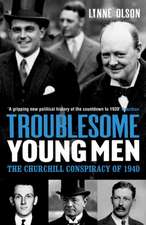Soviet Street Children and the Second World War: Welfare and Social Control under Stalin
Autor Dr Olga Kucherenkoen Limba Engleză Paperback – 24 ian 2018
| Toate formatele și edițiile | Preț | Express |
|---|---|---|
| Paperback (1) | 237.75 lei 6-8 săpt. | |
| Bloomsbury Publishing – 24 ian 2018 | 237.75 lei 6-8 săpt. | |
| Hardback (1) | 774.03 lei 6-8 săpt. | |
| Bloomsbury Publishing – 13 iul 2016 | 774.03 lei 6-8 săpt. |
Preț: 237.75 lei
Preț vechi: 305.76 lei
-22% Nou
Puncte Express: 357
Preț estimativ în valută:
45.49€ • 48.65$ • 37.93£
45.49€ • 48.65$ • 37.93£
Carte tipărită la comandă
Livrare economică 18 aprilie-02 mai
Preluare comenzi: 021 569.72.76
Specificații
ISBN-13: 9781350058118
ISBN-10: 1350058114
Pagini: 256
Ilustrații: 14 bw illus
Dimensiuni: 234 x 157 x 16 mm
Greutate: 0.36 kg
Ediția:NIPPOD
Editura: Bloomsbury Publishing
Colecția Bloomsbury Academic
Locul publicării:London, United Kingdom
ISBN-10: 1350058114
Pagini: 256
Ilustrații: 14 bw illus
Dimensiuni: 234 x 157 x 16 mm
Greutate: 0.36 kg
Ediția:NIPPOD
Editura: Bloomsbury Publishing
Colecția Bloomsbury Academic
Locul publicării:London, United Kingdom
Caracteristici
The first critical examination - in English or Russian - of street children in wartime Russia
Notă biografică
Olga Kucherenko is the author of Little Soldiers: How Soviet Children Went to War, 1941-45 (2011). She is currently working on a new project, investigating Anglo-Soviet relations in the 1940s.
Cuprins
AcknowledgmentsList of IllustrationsTerms and TransliterationAbbreviations and Archive ReferencesGlossaryIntroductionPart I - Bezotsovshchina1. Rolling Stones2. The Crime Wave3. The Great Migration4. Efforts to Help5. CodaPart II - Step-Motherland6. Empty Promises7. Forced Displacement8. Making Labourers into Criminals 9. Law and Order Soviet Style10. CodaPart III - In Beria's Care11. State House12. Maloletka13. Challenges to Authority14. Educating Through Labour15. CodaConclusionAppendixSelect BibliographyIndex
Recenzii
This volume contributes to four subjects in Soviet history: the history of the home front during World War II, childhood, social welfare policies and institutions, and children's colonies and labor in the Gulag. Anyone teaching or pursuing research on these topics will find valuable information to enrich lectures or explain the institutions encountered in other research materials . [The] text is also accessible to advanced undergraduate students.
Uncovering the stories of wartime street children, Kucherenko makes a significant contribution to the history of childhood. The book also constitutes a provocative intervention in debates on the nature of Stalinism. Kucherenko not only challenges the heroic narrative of exemplary Soviet care for children; she argues that Soviet officials indifferent to children's suffering and partial to repression as a means of social control deserve much of the blame for producing, brutalizing, and then forgetting millions of homeless and abandoned children.
This detailed and well-researched book is a welcome addition to the literature on homeless children in the Soviet era. With its extensive documentation, glossary, and bibliography, Kucherenko's work is useful both to scholars and to the lay reader.
[Kucherenko's] exhaustive arguments, understanding of the period, and well researched text underlines the quality of her work and its successful additional to the existing literature.
Kucherenko's rigorously researched work makes an important contribution to the historiography of the Great Patriotic War and is useful to historians of childhood across other international contexts and chronologies.
Kucherenko offers a well-researched and well-written addition to the histories of the Second World War . With rich source material, it provides fascinating case studies and excellent analyses, which help to unearth what the Soviet leadership had meant to bury.
Kucherenko's first monograph Little Soldiers: How Soviet Children Went to War, 1941-1945 established her as one of the foremost social historians of the Great Patriotic War. Her new work addresses the fate of Soviet displaced children behind the lines. It is similarly grounded in extensive and meticulous original research and written with the same analytical clarity, fluency of exposition and moral sensitivity. This book represents an important new contribution to our understanding of Stalinist state-society relations and population policy during wartime as well as to the history of twentieth century childhood and youth.
This excellent work is a much-needed addition to the narrative of the Great Patriotic War, filling a gaping hole in the scholarship and in the public memory of the war. Kucherenko provides a meticulously-researched, nuanced exploration of the plight of wartime street children, the conditions which put them there, and the complex of state institutions, provincial authorities, local officials, professionals, and volunteers tasked to deal with them. Moving skillfully between orphanage and trade school, juvenile court and holding cell, labor colony and train car, she reveals the world of children caught between a horrific war and a state system that could not help them.
Soviet Street Children and the Second World War convincingly challenges Soviet image makers and subsequent historians who have asserted that throughout the war the Soviet state had children's best interest in mind. Instead, we find a regime that actively criminalized behaviors and institutionalized children to an unprecedented degree. Controlling the population became more important than protecting children, and new wartime policies exacerbated vagrancy and deviance while further marginalizing many children. Olga Kucherenko's engaging writing and meticulous research illuminates a poorly understood aspect of Soviet children's lives during World War II and provides a much needed corrective to the historical record.
The study is argumentative but scholarly, including 69 pages of supporting materials.
Uncovering the stories of wartime street children, Kucherenko makes a significant contribution to the history of childhood. The book also constitutes a provocative intervention in debates on the nature of Stalinism. Kucherenko not only challenges the heroic narrative of exemplary Soviet care for children; she argues that Soviet officials indifferent to children's suffering and partial to repression as a means of social control deserve much of the blame for producing, brutalizing, and then forgetting millions of homeless and abandoned children.
This detailed and well-researched book is a welcome addition to the literature on homeless children in the Soviet era. With its extensive documentation, glossary, and bibliography, Kucherenko's work is useful both to scholars and to the lay reader.
[Kucherenko's] exhaustive arguments, understanding of the period, and well researched text underlines the quality of her work and its successful additional to the existing literature.
Kucherenko's rigorously researched work makes an important contribution to the historiography of the Great Patriotic War and is useful to historians of childhood across other international contexts and chronologies.
Kucherenko offers a well-researched and well-written addition to the histories of the Second World War . With rich source material, it provides fascinating case studies and excellent analyses, which help to unearth what the Soviet leadership had meant to bury.
Kucherenko's first monograph Little Soldiers: How Soviet Children Went to War, 1941-1945 established her as one of the foremost social historians of the Great Patriotic War. Her new work addresses the fate of Soviet displaced children behind the lines. It is similarly grounded in extensive and meticulous original research and written with the same analytical clarity, fluency of exposition and moral sensitivity. This book represents an important new contribution to our understanding of Stalinist state-society relations and population policy during wartime as well as to the history of twentieth century childhood and youth.
This excellent work is a much-needed addition to the narrative of the Great Patriotic War, filling a gaping hole in the scholarship and in the public memory of the war. Kucherenko provides a meticulously-researched, nuanced exploration of the plight of wartime street children, the conditions which put them there, and the complex of state institutions, provincial authorities, local officials, professionals, and volunteers tasked to deal with them. Moving skillfully between orphanage and trade school, juvenile court and holding cell, labor colony and train car, she reveals the world of children caught between a horrific war and a state system that could not help them.
Soviet Street Children and the Second World War convincingly challenges Soviet image makers and subsequent historians who have asserted that throughout the war the Soviet state had children's best interest in mind. Instead, we find a regime that actively criminalized behaviors and institutionalized children to an unprecedented degree. Controlling the population became more important than protecting children, and new wartime policies exacerbated vagrancy and deviance while further marginalizing many children. Olga Kucherenko's engaging writing and meticulous research illuminates a poorly understood aspect of Soviet children's lives during World War II and provides a much needed corrective to the historical record.
The study is argumentative but scholarly, including 69 pages of supporting materials.









